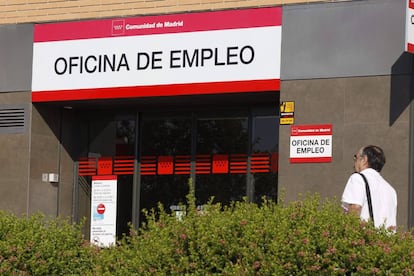Unemployment falls to 20%, its lowest level since the summer of 2010
More than 271,000 jobs created in Spain between April and June, mostly in services sector

Once again, the summer holiday season has breathed new life into Spain’s ailing labor market. Over the last quarter, the latest figures show that unemployment has fallen by a percentage point to 20%, its lowest level in six years.
Nevertheless, unemployment remains stubbornly high in Spain, and is the second highest in the EU after Greece.
The number of people officially registered as jobless in Spain is now 4,574,700, a drop of 216,700 people compared to the same period last year.
Over the last quarter, around 271,400 jobs have been created, meaning that 18,301,000 people are officially in employment. The services sector has registered the biggest increase, gaining 227,300 jobs, with construction providing a further 45,600, industry 15,700, while 17,200 positions were lost in agriculture.
In the last 18 months, there has been a 10% increase in the number of temporary workers, from 3.4 million up to 3.7 million
By region, the biggest increase has been in the Balearics with 56,000 new jobs, Catalonia with 53,700, and Murcia with 28,400. Some 11,900 jobs were lost in the Canary Islands, and 4,200 in Navarre.
Spain has been harder hit by unemployment than most of the EU over the last eight years, and has proved unable to generate news jobs in large numbers. The country has endured a jobless rate of over 20% for almost six years.
Between the time that employment began to flag in 2007 and the moment it hit rock bottom in early 2014, one out of every five jobs in Spain was axed, representing nearly four million positions.
By early 2013, the jobless rate had soared to around 27%. From January to March of that year, more than 6.2 million people were without work.
Spain’s unemployment is so high partly because of particular local forces that have existed for decades. Unemployment above 20% is not uncommon in Spain. In fact, it has been at that level in three periods since Spain’s transition to democracy in the 1970s. And, ominously, from the previous unemployment rate peak in the 1990s, it took 14 years for it to decline to the wider European level.
But many of the jobs being created are temporary positions. In the last 18 months, there has been a 10% increase in the number of temporary workers, from 3.4 million up to 3.7 million. The temporary employment rate is now 25%, nearly 1.5 percentage points higher than in the same period last year.
Sign up for our newsletter
EL PAÍS English Edition has launched a weekly newsletter. Sign up today to receive a selection of our best stories in your inbox every Saturday morning. For full details about how to subscribe, click here
Seasonal work has always provided an annual boost for the employment figures in Spain, and this time is no exception. But the fact that it remains so strong two years later shows that employers are still not confident enough about the future to offer permanent positions.
Other indicators give an idea of the impact of the crisis on Spanish households: there are now more than 700,000 households without any kind of income, and more than 1.5 million where no member of the family has a job. And there’s the matter of the country’s youth unemployment (those under 25 who are actively seeking jobs): an almost incomprehensible 45.5 percent.
By the end of the third quarter of the year, unemployment is expected to have continued falling, although in May, the Spanish government said it did not expect the jobless rate to fall below 15 percent until 2019.
English version by Nick Lyne.
Tu suscripción se está usando en otro dispositivo
¿Quieres añadir otro usuario a tu suscripción?
Si continúas leyendo en este dispositivo, no se podrá leer en el otro.
FlechaTu suscripción se está usando en otro dispositivo y solo puedes acceder a EL PAÍS desde un dispositivo a la vez.
Si quieres compartir tu cuenta, cambia tu suscripción a la modalidad Premium, así podrás añadir otro usuario. Cada uno accederá con su propia cuenta de email, lo que os permitirá personalizar vuestra experiencia en EL PAÍS.
¿Tienes una suscripción de empresa? Accede aquí para contratar más cuentas.
En el caso de no saber quién está usando tu cuenta, te recomendamos cambiar tu contraseña aquí.
Si decides continuar compartiendo tu cuenta, este mensaje se mostrará en tu dispositivo y en el de la otra persona que está usando tu cuenta de forma indefinida, afectando a tu experiencia de lectura. Puedes consultar aquí los términos y condiciones de la suscripción digital.
More information
Archived In
Últimas noticias
From Andorra to Gibraltar, a black market for Ozempic exploits its success: ‘They’re the most sought-after products in the world’
Magnets in their heads: How some animals guide themselves using the Earth’s magnetic field
From Hungary’s Orbán to Chile’s Kast: How Trump helps turbo charge the far right
The brief rise and retreat of Generation Z in Mexico
Most viewed
- Why we lost the habit of sleeping in two segments and how that changed our sense of time
- Trump’s obsession with putting his name on everything is unprecedented in the United States
- Charles Dubouloz, mountaineering star, retires at 36 with a farewell tour inspired by Walter Bonatti
- The Florida Keys tourist paradise is besieged by immigration agents: ‘We’ve never seen anything like this’
- Living in a motorhome due to soaring housing prices in Madrid: ‘I got used to it quickly, but I don’t idealize it’










































